complexType
Section
element Section/SectionIdentifier
element Section/SequenceOfCourse
element Section/EducationalEnvironment
element Section/MediumOfInstruction
element Section/PopulationServed
element Section/AvailableCredits
element Section/SectionCharacteristic
element Section/InstructionLanguage
element Section/CourseOfferingReference
element Section/SchoolReference
element Section/LocationReference
element Section/ClassPeriodReference
element Section/ProgramReference
| diagram |  |
||||||||||||||
| namespace | http://ed-fi.org/0210 | ||||||||||||||
| type | extension of ComplexObjectType | ||||||||||||||
| properties |
|
||||||||||||||
| children | SectionIdentifier SequenceOfCourse EducationalEnvironment MediumOfInstruction PopulationServed AvailableCredits SectionCharacteristic InstructionLanguage CourseOfferingReference SchoolReference LocationReference ClassPeriodReference ProgramReference | ||||||||||||||
| attributes |
|
||||||||||||||
| annotation |
|
||||||||||||||
| source | <xs:complexType name="Section"> <xs:annotation> <xs:documentation>This entity represents a setting in which organized instruction of course content is provided, in-person or otherwise, to one or more students for a given period of time. A course offering may be offered to more than one section.</xs:documentation> <xs:appinfo> <ann:TypeGroup>Domain Entity</ann:TypeGroup> </xs:appinfo> </xs:annotation> <xs:complexContent> <xs:extension base="ComplexObjectType"> <xs:sequence> <xs:element name="SectionIdentifier" type="SectionIdentifier"> <xs:annotation> <xs:documentation>The local identifier assigned to a section.</xs:documentation> </xs:annotation> </xs:element> <xs:element name="SequenceOfCourse" type="SequenceOfCourse" minOccurs="0"> <xs:annotation> <xs:documentation>When a section is part of a sequence of parts for a course, the number of the sequence. If the course has only one part, the value of this section attribute should be 1.</xs:documentation> </xs:annotation> </xs:element> <xs:element name="EducationalEnvironment" type="EducationalEnvironmentType" minOccurs="0"> <xs:annotation> <xs:documentation>The setting in which a child receives education and related services; for example: Center-based instruction Home-based instruction Hospital class Mainstream Residential care and treatment facility ...</xs:documentation> </xs:annotation> </xs:element> <xs:element name="MediumOfInstruction" type="MediumOfInstructionType" minOccurs="0"> <xs:annotation> <xs:documentation>The media through which teachers provide instruction to students and students and teachers communicate about instructional matters; for example: Technology-based instruction in classroom Correspondence instruction Face-to-face instruction Virtual/On-line Distance learning Center-based instruction ...</xs:documentation> </xs:annotation> </xs:element> <xs:element name="PopulationServed" type="PopulationServedType" minOccurs="0"> <xs:annotation> <xs:documentation>The type of students the Section is offered and tailored to; for example: Bilingual students Remedial education students Gifted and talented students Career and Technical Education students Special education students ...</xs:documentation> </xs:annotation> </xs:element> <xs:element name="AvailableCredits" type="Credits" minOccurs="0"> <xs:annotation> <xs:documentation>The amount of credit available to a student who successfully meets the objectives of the course. AvailableCredits are measured in Carnegie units, A course meeting every day for one period of the school day over the span of a school year offers one Carnegie unit. See publication: U.S. Department of Education, NCES, 2007-341, Secondary School Course Classification System: School Codes for the Exchange of Data (SCED).</xs:documentation> </xs:annotation> </xs:element> <xs:element name="SectionCharacteristic" type="SectionCharacteristicDescriptorReferenceType" minOccurs="0" maxOccurs="unbounded"> <xs:annotation> <xs:documentation>Reflects important characteristics of the Section, such as whether or not attendance is taken and the Section is graded.</xs:documentation> <xs:appinfo> <ann:Descriptor>SectionCharacteristicDescriptor</ann:Descriptor> </xs:appinfo> </xs:annotation> </xs:element> <xs:element name="InstructionLanguage" type="LanguageDescriptorReferenceType" minOccurs="0"> <xs:annotation> <xs:documentation>The primary language of instruction, if omitted English is assumed.</xs:documentation> <xs:appinfo> <ann:Descriptor>LanguageDescriptor</ann:Descriptor> </xs:appinfo> </xs:annotation> </xs:element> <xs:element name="CourseOfferingReference" type="CourseOfferingReferenceType"> <xs:annotation> <xs:documentation>The course offering taught in the Section.</xs:documentation> </xs:annotation> </xs:element> <xs:element name="SchoolReference" type="SchoolReferenceType" minOccurs="0"> <xs:annotation> <xs:documentation>The school where the Section is taught.</xs:documentation> </xs:annotation> </xs:element> <xs:element name="LocationReference" type="LocationReferenceType" minOccurs="0"> <xs:annotation> <xs:documentation>The location, typically a classroom, where the Section meets.</xs:documentation> </xs:annotation> </xs:element> <xs:element name="ClassPeriodReference" type="ClassPeriodReferenceType" minOccurs="0" maxOccurs="unbounded"> <xs:annotation> <xs:documentation>The class period during which the Section meets.</xs:documentation> </xs:annotation> </xs:element> <xs:element name="ProgramReference" type="ProgramReferenceType" minOccurs="0" maxOccurs="unbounded"> <xs:annotation> <xs:documentation>Optional reference to program (e.g., CTE) to which the Section is associated.</xs:documentation> </xs:annotation> </xs:element> </xs:sequence> </xs:extension> </xs:complexContent> </xs:complexType> |
element Section/SectionIdentifier
| diagram |  |
|||||||||
| namespace | http://ed-fi.org/0210 | |||||||||
| type | SectionIdentifier | |||||||||
| properties |
|
|||||||||
| facets |
|
|||||||||
| annotation |
|
|||||||||
| source | <xs:element name="SectionIdentifier" type="SectionIdentifier"> <xs:annotation> <xs:documentation>The local identifier assigned to a section.</xs:documentation> </xs:annotation> </xs:element> |
element Section/SequenceOfCourse
| diagram | 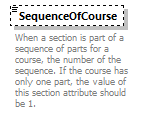 |
|||||||||
| namespace | http://ed-fi.org/0210 | |||||||||
| type | SequenceOfCourse | |||||||||
| properties |
|
|||||||||
| facets |
|
|||||||||
| annotation |
|
|||||||||
| source | <xs:element name="SequenceOfCourse" type="SequenceOfCourse" minOccurs="0"> <xs:annotation> <xs:documentation>When a section is part of a sequence of parts for a course, the number of the sequence. If the course has only one part, the value of this section attribute should be 1.</xs:documentation> </xs:annotation> </xs:element> |
element Section/EducationalEnvironment
| diagram | 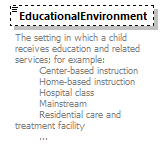 |
||||||||||||||||||||||||||||||||||||||||||
| namespace | http://ed-fi.org/0210 | ||||||||||||||||||||||||||||||||||||||||||
| type | EducationalEnvironmentType | ||||||||||||||||||||||||||||||||||||||||||
| properties |
|
||||||||||||||||||||||||||||||||||||||||||
| facets |
|
||||||||||||||||||||||||||||||||||||||||||
| annotation |
|
||||||||||||||||||||||||||||||||||||||||||
| source | <xs:element name="EducationalEnvironment" type="EducationalEnvironmentType" minOccurs="0"> <xs:annotation> <xs:documentation>The setting in which a child receives education and related services; for example: Center-based instruction Home-based instruction Hospital class Mainstream Residential care and treatment facility ...</xs:documentation> </xs:annotation> </xs:element> |
element Section/MediumOfInstruction
| diagram | 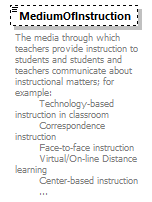 |
||||||||||||||||||||||||||||||||||||||||||||||||
| namespace | http://ed-fi.org/0210 | ||||||||||||||||||||||||||||||||||||||||||||||||
| type | MediumOfInstructionType | ||||||||||||||||||||||||||||||||||||||||||||||||
| properties |
|
||||||||||||||||||||||||||||||||||||||||||||||||
| facets |
|
||||||||||||||||||||||||||||||||||||||||||||||||
| annotation |
|
||||||||||||||||||||||||||||||||||||||||||||||||
| source | <xs:element name="MediumOfInstruction" type="MediumOfInstructionType" minOccurs="0"> <xs:annotation> <xs:documentation>The media through which teachers provide instruction to students and students and teachers communicate about instructional matters; for example: Technology-based instruction in classroom Correspondence instruction Face-to-face instruction Virtual/On-line Distance learning Center-based instruction ...</xs:documentation> </xs:annotation> </xs:element> |
element Section/PopulationServed
| diagram | 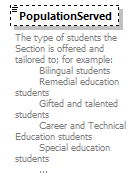 |
||||||||||||||||||||||||||||||||||||
| namespace | http://ed-fi.org/0210 | ||||||||||||||||||||||||||||||||||||
| type | PopulationServedType | ||||||||||||||||||||||||||||||||||||
| properties |
|
||||||||||||||||||||||||||||||||||||
| facets |
|
||||||||||||||||||||||||||||||||||||
| annotation |
|
||||||||||||||||||||||||||||||||||||
| source | <xs:element name="PopulationServed" type="PopulationServedType" minOccurs="0"> <xs:annotation> <xs:documentation>The type of students the Section is offered and tailored to; for example: Bilingual students Remedial education students Gifted and talented students Career and Technical Education students Special education students ...</xs:documentation> </xs:annotation> </xs:element> |
element Section/AvailableCredits
| diagram | 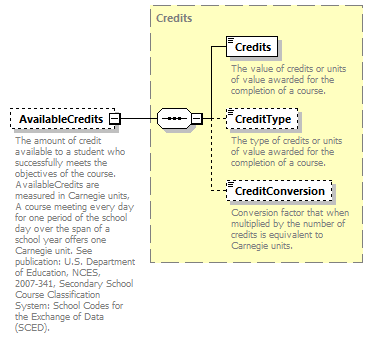 |
||||||
| namespace | http://ed-fi.org/0210 | ||||||
| type | Credits | ||||||
| properties |
|
||||||
| children | Credits CreditType CreditConversion | ||||||
| annotation |
|
||||||
| source | <xs:element name="AvailableCredits" type="Credits" minOccurs="0"> <xs:annotation> <xs:documentation>The amount of credit available to a student who successfully meets the objectives of the course. AvailableCredits are measured in Carnegie units, A course meeting every day for one period of the school day over the span of a school year offers one Carnegie unit. See publication: U.S. Department of Education, NCES, 2007-341, Secondary School Course Classification System: School Codes for the Exchange of Data (SCED).</xs:documentation> </xs:annotation> </xs:element> |
element Section/SectionCharacteristic
| diagram | 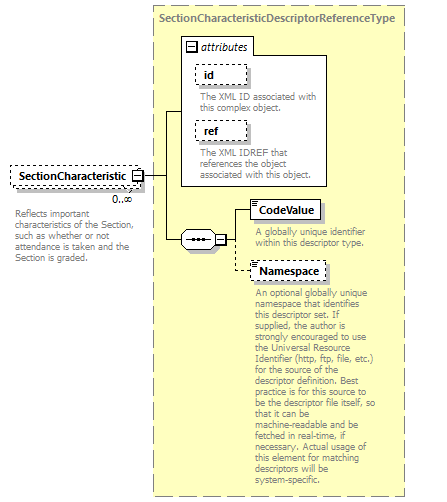 |
||||||||||||||||||||||
| namespace | http://ed-fi.org/0210 | ||||||||||||||||||||||
| type | SectionCharacteristicDescriptorReferenceType | ||||||||||||||||||||||
| properties |
|
||||||||||||||||||||||
| children | CodeValue Namespace | ||||||||||||||||||||||
| attributes |
|
||||||||||||||||||||||
| annotation |
|
||||||||||||||||||||||
| source | <xs:element name="SectionCharacteristic" type="SectionCharacteristicDescriptorReferenceType" minOccurs="0" maxOccurs="unbounded"> <xs:annotation> <xs:documentation>Reflects important characteristics of the Section, such as whether or not attendance is taken and the Section is graded.</xs:documentation> <xs:appinfo> <ann:Descriptor>SectionCharacteristicDescriptor</ann:Descriptor> </xs:appinfo> </xs:annotation> </xs:element> |
element Section/InstructionLanguage
| diagram |  |
||||||||||||||||||||||
| namespace | http://ed-fi.org/0210 | ||||||||||||||||||||||
| type | LanguageDescriptorReferenceType | ||||||||||||||||||||||
| properties |
|
||||||||||||||||||||||
| children | CodeValue Namespace | ||||||||||||||||||||||
| attributes |
|
||||||||||||||||||||||
| annotation |
|
||||||||||||||||||||||
| source | <xs:element name="InstructionLanguage" type="LanguageDescriptorReferenceType" minOccurs="0"> <xs:annotation> <xs:documentation>The primary language of instruction, if omitted English is assumed.</xs:documentation> <xs:appinfo> <ann:Descriptor>LanguageDescriptor</ann:Descriptor> </xs:appinfo> </xs:annotation> </xs:element> |
element Section/CourseOfferingReference
| diagram | 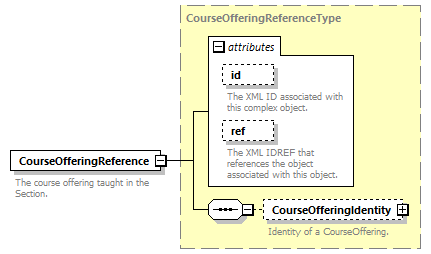 |
||||||||||||||||||||||
| namespace | http://ed-fi.org/0210 | ||||||||||||||||||||||
| type | CourseOfferingReferenceType | ||||||||||||||||||||||
| properties |
|
||||||||||||||||||||||
| children | CourseOfferingIdentity | ||||||||||||||||||||||
| attributes |
|
||||||||||||||||||||||
| annotation |
|
||||||||||||||||||||||
| source | <xs:element name="CourseOfferingReference" type="CourseOfferingReferenceType"> <xs:annotation> <xs:documentation>The course offering taught in the Section.</xs:documentation> </xs:annotation> </xs:element> |
element Section/SchoolReference
| diagram | 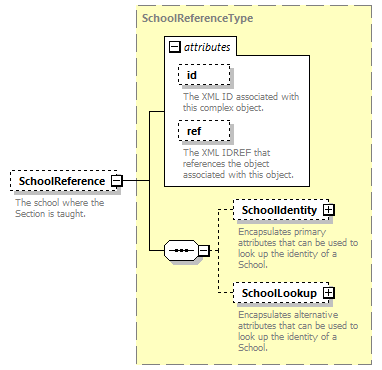 |
||||||||||||||||||||||
| namespace | http://ed-fi.org/0210 | ||||||||||||||||||||||
| type | SchoolReferenceType | ||||||||||||||||||||||
| properties |
|
||||||||||||||||||||||
| children | SchoolIdentity SchoolLookup | ||||||||||||||||||||||
| attributes |
|
||||||||||||||||||||||
| annotation |
|
||||||||||||||||||||||
| source | <xs:element name="SchoolReference" type="SchoolReferenceType" minOccurs="0"> <xs:annotation> <xs:documentation>The school where the Section is taught.</xs:documentation> </xs:annotation> </xs:element> |
element Section/LocationReference
| diagram | 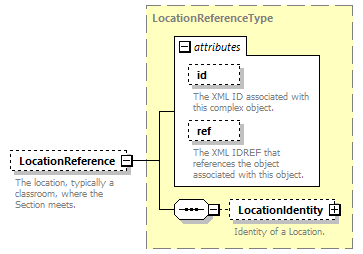 |
||||||||||||||||||||||
| namespace | http://ed-fi.org/0210 | ||||||||||||||||||||||
| type | LocationReferenceType | ||||||||||||||||||||||
| properties |
|
||||||||||||||||||||||
| children | LocationIdentity | ||||||||||||||||||||||
| attributes |
|
||||||||||||||||||||||
| annotation |
|
||||||||||||||||||||||
| source | <xs:element name="LocationReference" type="LocationReferenceType" minOccurs="0"> <xs:annotation> <xs:documentation>The location, typically a classroom, where the Section meets.</xs:documentation> </xs:annotation> </xs:element> |
element Section/ClassPeriodReference
| diagram | 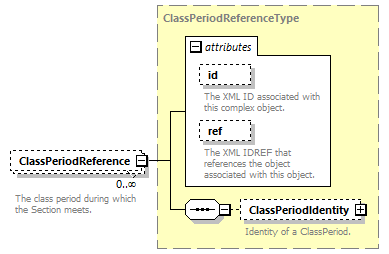 |
||||||||||||||||||||||
| namespace | http://ed-fi.org/0210 | ||||||||||||||||||||||
| type | ClassPeriodReferenceType | ||||||||||||||||||||||
| properties |
|
||||||||||||||||||||||
| children | ClassPeriodIdentity | ||||||||||||||||||||||
| attributes |
|
||||||||||||||||||||||
| annotation |
|
||||||||||||||||||||||
| source | <xs:element name="ClassPeriodReference" type="ClassPeriodReferenceType" minOccurs="0" maxOccurs="unbounded"> <xs:annotation> <xs:documentation>The class period during which the Section meets.</xs:documentation> </xs:annotation> </xs:element> |
element Section/ProgramReference
| diagram | 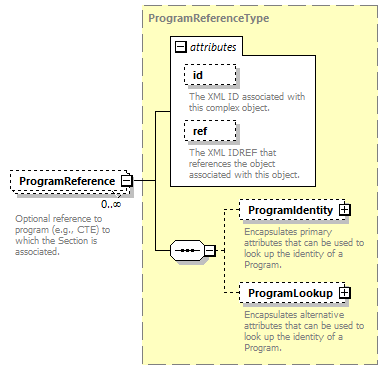 |
||||||||||||||||||||||
| namespace | http://ed-fi.org/0210 | ||||||||||||||||||||||
| type | ProgramReferenceType | ||||||||||||||||||||||
| properties |
|
||||||||||||||||||||||
| children | ProgramIdentity ProgramLookup | ||||||||||||||||||||||
| attributes |
|
||||||||||||||||||||||
| annotation |
|
||||||||||||||||||||||
| source | <xs:element name="ProgramReference" type="ProgramReferenceType" minOccurs="0" maxOccurs="unbounded"> <xs:annotation> <xs:documentation>Optional reference to program (e.g., CTE) to which the Section is associated.</xs:documentation> </xs:annotation> </xs:element> |